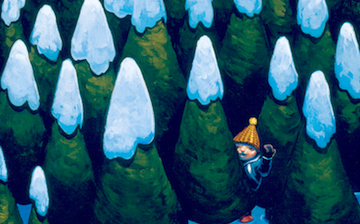Hiking is an outdoor activity which consists of walking in natural environments, often on hiking trails. It is such a popular activity that there are numerous hiking organizations worldwide. The health benefits of different types of hiking have been confirmed in studies.[1] The word hiking is understood in all English-speaking countries, but there are differences in usage.
Hikers often seek beautiful natural environments in which to hike. These environments are often fragile: hikers may accidentally destroy the environment that they enjoy. While the action of an individual may not strongly affect the environment, the mass effect of a large number of hikers can degrade the environment. For example, gathering wood in an alpine area to start a fire may be harmless if done once (except for wildfire risk). Years of gathering wood, however, can strip an alpine area of valuable nutrients.[4] Generally, protected areas such as parks have regulations in place to protect the environment. If hikers follow such regulations, their impact can be minimized.[4] Such regulations include forbidding wood fires, restricting camping to established camp sites, disposing or packing out faecal matter, imposing a quota on the number of hikers per mile.
Many hikers espouse the philosophy of Leave No Trace: hiking in a way such that future hikers cannot detect the presence of previous hikers. Practitioners of this philosophy obey its strictures, even in the absence of area regulations. Followers of this practice follow strict practices on dealing with food waste, food packaging, and alterations to the surrounding environment.
Human waste is often a major source of environmental impact from hiking.[4] These wastes can contaminate the watershed and make other hikers ill. Bacterial contamination can be avoided by digging ‘catholes‘ 10 to 25 cm (4 to 10 inches) deep, depending on local soil composition and covering after use. If these catholes are dug at least 60 m (200 feet) away from water sources and trails, the risk of contamination is minimized. Many hikers warn other hikers about the location of their catholes by marking them with sticks stuck into the ground.[citation needed]
Protecting the trails and nature areas may be taken further with the idea of taking out more than you brought in. If every responsible hiker took away some of the garbage left by others, as well as their own, trails and nature areas would gradually become pristine.
Sometimes hikers enjoy viewing rare or endangered species. However, some species (such as martens or bighorn sheep) are very sensitive to the presence of humans, especially around mating season. To prevent adverse impact, hikers should learn the habits and habitats of endangered species.
There is one situation where an individual hiker can make a large impact on an ecosystem: inadvertently starting a wildfire. For example, in 2005, a Czech backpacker burned 7% of Torres del Paine National Park in Chile by knocking over an illegal gas portable stove.[5] Obeying area regulations and setting up cooking devices on designated areas (or if necessary on bare ground) will reduce the risk of wildfire.
(From Wikipedia, December 14th, 2010)


